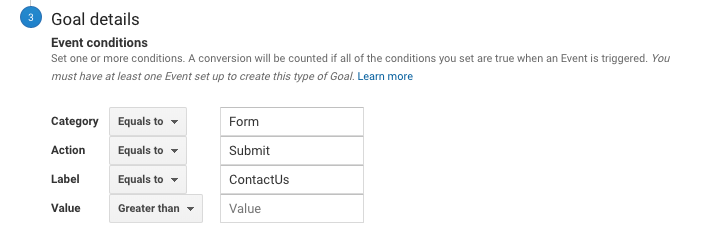What Data Is Google Analytics Goals Unable to Track and Why
What Data Is Google Analytics Goals Unable to Track and Why
Blog Article
Unveiling the Blind Destinations: Comprehending What Google Analytics Goals Can not Measure
In the realm of digital analytics, Google Analytics stands as a powerful device for monitoring and evaluating on-line individual communications. Amidst its durable capabilities, there exist blind places that commonly evade measurement. what data is google analytics goals unable to track. Understanding what Google Analytics goals can not gauge is crucial for obtaining a comprehensive sight of individual actions and interaction. As we look into the ins and outs of these blind places, we uncover a complicated web of uncharted regions that hold beneficial understandings into individual activities and motivations, challenging traditional wisdom and shedding light on the restrictions of our data-driven understanding.
Customer Habits on External Platforms
Comprehending exactly how individuals engage on outside systems is essential for maximizing online techniques. External platforms, such as social networks networks, recommendation websites, and online forums, play a significant function in driving traffic to a firm's website. By examining individual actions on these systems, organizations can obtain important insights right into the performance of their advertising efforts and the choices of their target market.
One secret aspect of individual actions on exterior platforms is the reference source. By tracking where the individuals are originating from, companies can identify which platforms are driving the most traffic to their website. This information can assist business allot their sources a lot more effectively, concentrating on the platforms that generate the very best results.

Offline Communications and conversions
Examining individual actions on exterior systems provides beneficial insights into on-line approaches; nonetheless, taking into consideration offline conversions and interactions is similarly critical for a thorough understanding of a business's total efficiency. Offline conversions, such as in-store purchases or phone questions, play a significant role in numerous businesses' success.

Acknowledgment Beyond Last Click
When diving into the world of electronic marketing analytics, it becomes necessary to look beyond the single touchpoint of the last click for a more detailed understanding of acknowledgment. While Google Analytics provides valuable insights right into individual actions, depending entirely on last-click attribution can be restricting - what data is google analytics goals unable to track. Attribution models that exceed the last click use go to my site an extra nuanced view of the consumer trip, taking into consideration all the touchpoints that cause a conversion
Attribution past the last click permits marketing experts to assign credit report to various interactions along the conversion path, offering a more clear picture of the effectiveness of different advertising and marketing networks. By discovering multi-touch attribution versions such as linear, time degeneration, or position-based attribution, companies can much better designate their advertising and marketing budgets and enhance their approaches for maximum impact.
Understanding the influence of each touchpoint in the conversion process is crucial for making notified decisions and making the most of ROI. By welcoming attribution past the last click, organizations can obtain much deeper insights right into consumer actions and tailor their marketing initiatives more properly.
Cross-Device and Cross-Browser Tracking

Likewise, cross-browser monitoring matches cross-device monitoring by recording customer actions as they change in between various web browsers. Comprehending just how individuals communicate with sites on various browsers can help online marketers enhance their online experiences to make certain consistency and capability throughout different platforms.
Qualitative Data and User Intent
Recognizing customer intent through qualitative information evaluation is important for creating targeted electronic advertising techniques that resonate with the demands and preferences of the target audience. Qualitative information supplies insights right into the 'why' behind user activities, clarifying inspirations, emotions, and preferences that quantitative data alone can not record. By evaluating individual comments, comments, and interactions, marketing professionals can uncover beneficial information about customer intent, permitting them to tailor their messaging, content, and offerings to better align with what their target market is seeking.
Qualitative data also aids in understanding the context in which individuals engage with a website or app. This contextual understanding allows marketing professionals to see this create more individualized and relevant experiences, ultimately driving greater engagement and conversion prices. By delving click to read more into individual intent with qualitative data analysis, businesses can obtain a much deeper understanding of their target market, resulting in extra effective advertising methods that meet customers' assumptions and needs.
Final Thought
Finally, Google Analytics objectives have constraints in gauging individual actions on exterior systems, offline conversions, acknowledgment past last click, cross-browser and cross-device monitoring, and qualitative data connected to user intent. what data is google analytics goals unable to track. It is very important for companies to be knowledgeable about these unseen areas in order to supplement their data analysis with various other tools and approaches to acquire a much more extensive understanding of their target market and boost their general digital marketing strategies
By examining user behavior on these systems, companies can obtain important understandings right into the performance of their marketing efforts and the choices of their target audience.
Examining user behavior on outside systems supplies important understandings right into on the internet approaches; however, thinking about offline conversions and interactions is equally critical for an extensive understanding of a company's overall efficiency.In digital advertising and marketing analytics, relocating past last-click acknowledgment to check out cross-device and cross-browser tracking is vital for gaining an all natural understanding of individual communications across different platforms and tools. By assessing user feedback, remarks, and communications, marketing professionals can discover valuable information concerning customer intent, enabling them to tailor their messaging, web content, and offerings to better straighten with what their target market is seeking.
By diving right into customer intent with qualitative data evaluation, businesses can obtain a much deeper understanding of their target audience, leading to extra efficient advertising and marketing approaches that satisfy individuals' needs and expectations.
Report this page